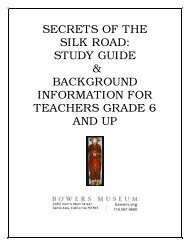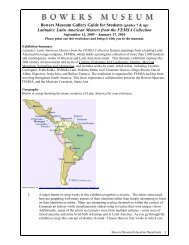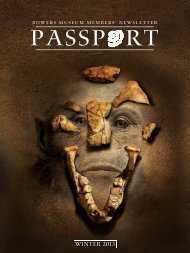A Resource Guide for Students and Teachers - Bowers Museum
A Resource Guide for Students and Teachers - Bowers Museum
A Resource Guide for Students and Teachers - Bowers Museum
You also want an ePaper? Increase the reach of your titles
YUMPU automatically turns print PDFs into web optimized ePapers that Google loves.
Archer’s shoe showing<br />
details of hemp sole<br />
to an invasion of the tombs soon<br />
after he died. In addition to what was<br />
plundered, the roof was burned <strong>and</strong><br />
fell, smashing most of the statues.<br />
Each statue bears an inscription<br />
of one of the 87 <strong>for</strong>emen in charge of<br />
the construction of the army. Some<br />
worked <strong>for</strong> state workshops run by the<br />
central government. Some worked<br />
<strong>for</strong> non-government workshops. It is<br />
estimated that there were about 1530<br />
craftsmen altogether who worked on<br />
the warriors. Each inscription tells<br />
the name of the workshop, the master<br />
artist, the office supervisor, <strong>and</strong> the<br />
year of the First Emperor’s reign that<br />
it was created. The inscriptions are<br />
found hidden on the statues, engraved<br />
or written with brush <strong>and</strong> black <strong>and</strong><br />
red ink.<br />
Hundreds of bronze swords,<br />
halberds, daggers, <strong>and</strong> battle axes<br />
<strong>and</strong> thous<strong>and</strong>s of arrowheads have<br />
been found mixed with the scattered<br />
pieces of the warriors. The swords<br />
<strong>and</strong> the tips of the arrowheads are<br />
still razor sharp. Some swords are<br />
made of an alloy of cooper, tin <strong>and</strong><br />
13 other elements including nickel,<br />
magnesium <strong>and</strong> cobalt. They are still<br />
covered with a coating of oxidized<br />
chrome, a true marvel of technology<br />
<strong>for</strong> any age. Probably the most<br />
amazing weapon of the time was the<br />
crossbow which used a three-part<br />
mechanism.<br />
The tomb of the First Emperor<br />
is believed to be a vast underground<br />
palace <strong>and</strong> will most likely prove to be<br />
one of the greatest marvels of all time<br />
when it is excavated. No documents<br />
from the Qin dynasty survive, so<br />
we must must rely on a description<br />
written 100 years later by Sima Qian,<br />
the official historian of the Han<br />
dynasty. Of course, he had a strong<br />
bias so we must be careful in reading<br />
what he says. He relays that over<br />
700,000 conscripts were used to build<br />
the compound. Sima Qian wrote,<br />
“As soon as the First Emperor<br />
became king of Qin, excavations<br />
<strong>and</strong> building had been started<br />
at Mount Li, while after he won<br />
the empire, more than 700,000<br />
conscripts from all parts of the<br />
country worked there. They dug<br />
through three underground<br />
streams <strong>and</strong> put down bronze<br />
<strong>for</strong> the outer coffin, <strong>and</strong> the tomb<br />
was filled with models of palaces,<br />
pavilions <strong>and</strong> offices as well as<br />
fine vessels, precious stones <strong>and</strong><br />
rarities. Craftsmen were ordered<br />
to fix up crossbows so that any<br />
thief breaking in would be shot.<br />
All the country’s streams, the<br />
Yellow River <strong>and</strong> the Yangtze were<br />
reproduced in mercury <strong>and</strong> by<br />
some mechanical means made to<br />
flow into a miniature ocean. The<br />
heavenly constellations were above<br />
<strong>and</strong> the regions of the earth below.<br />
The c<strong>and</strong>les were made of man-fish<br />
oil to ensure them burning <strong>for</strong> the<br />
longest possible time.”<br />
It is believed that the emperor’s<br />
burial chamber itself is 30-40 meters<br />
A bundle of bronze arrows found at the site of the terra cotta warriors in Xi’an, China.<br />
The bronze arrow tips survived, while the wooden shafts have disentigrated.<br />
(32.8 yards-43.7 yards) below the<br />
original ground level. Soil tests<br />
reveal high levels of mercury, so<br />
archaeologists are delaying excavation<br />
of the site until methods are developed<br />
to preserve what will be found there.<br />
For generations to come new <strong>and</strong><br />
exciting discoveries will be made in<br />
the tomb complex.<br />
15





